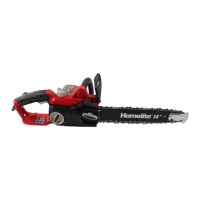
Do you have a question about the Homelite UT43100 and is the answer not in the manual?
Essential safety measures for operating the chain saw, including work area setup and keeping others away.
Guidelines for using extension cords, polarized plugs, and ensuring proper cord condition to prevent shock.
Requirements for wearing appropriate clothing, footwear, gloves, and eye/head protection for safe operation.
Emphasizes staying alert, using common sense, and avoiding operation when tired or impaired.
Detailed explanation of kickback, its causes, and how to minimize the risk through proper grip and operation.
Explanation of key safety features like SAFE-T-TIP®, low kickback chain, and guide bars.
Symbols indicating potential hazards, warnings, and required actions like reading the manual or wearing protection.
Symbols related to how to operate the saw, such as grip, hand use, and kickback warnings.
Symbols indicating the need for gloves, safety footwear, and keeping bystanders away.
Symbols for voltage, current, frequency, power, time, and types of electrical current.
Explains the meaning of DANGER, WARNING, and CAUTION signals for hazard identification.
Information on how to contact Homelite for parts, service, and repairs.
Explanation of the double insulation safety feature and its implications for grounding.
Guidelines for connecting the product to a suitable power supply (120V AC, 60 Hz).
Recommendations for selecting and using appropriate extension cords for outdoor operation.
Definitions for major parts of the chain saw, including handles, guide bar, chain, and safety devices.
Definitions for cutting processes like felling and bucking, and safety terms like kickback.
Detailed specifications for UT43100 and UT43120 models, including bar length, chain pitch, and weight.
Visual identification and explanation of major parts like handles, switch, and oil indicator.
Explanation of SAFE-T-TIP® guard, switch lock-out, and their roles in safe operation.
Instructions for safely unpacking the product and checking for all included items and damage.
Lists the items included in the product packaging for both models.
Warnings regarding modifying the product, connecting to power before assembly, and potential hazards.
Instructions on how to properly add bar and chain lubricant to the saw.
Lists the intended uses of the chain saw, such as limbing, felling, and woodcutting.
Steps for safely connecting the chain saw to an extension cord and power outlet.
Procedures for safely starting and stopping the chain saw motor.
Guidance on how to hold the saw firmly with both hands for optimal control and safety.
Instructions for maintaining balance and positioning the body correctly for safe cutting.
Step-by-step guide on how to practice cutting and perform basic sawing operations safely.
Safety guidelines for the work area, including material types, distances, and environmental conditions.
Warnings about felling trees during hazardous weather or in unsafe conditions.
Detailed steps and safety considerations for felling trees, including escape routes and wind effects.
How to make the initial notch cut in a tree to direct its fall.
Instructions for the back cut, including using wedges and maintaining the hinge wood.
Procedure for removing large buttress roots before felling a tree.
Techniques for cutting a fallen tree into desired log lengths safely.
Using wedges to hold cuts open and prevent pinching during bucking.
Techniques for cutting logs that are bent or under tension to avoid pinching.
How to cut a log from the top side, noting the saw's tendency to pull away.
How to cut a log from the underside, noting the saw's tendency to push back.
Techniques for safely removing branches from a fallen tree.
Instructions for trimming limbs from a live tree, including safety precautions.
Warnings and precautions for cutting springpoles which are bent under tension.
Basic cleaning procedures and precautions for plastic parts.
Information that bearings are pre-lubricated for the life of the unit.
Safety warnings and preparation steps before replacing the guide bar and chain.
Detailed steps for removing the old chain and preparing to install a new one.
Instructions for laying out, placing, and fitting the new saw chain onto the guide bar and sprocket.
Step-by-step guide on how to properly tension the saw chain for optimal performance and safety.
Guidelines for checking and retensioning the chain, including cold tension and warm operation differences.
Importance of using low-kickback chain and maintaining it for smooth, fast cutting.
Instructions on how to sharpen the chain cutters using a file, emphasizing uniformity and safety.
Correct angles for filing top plates to ensure efficient cutting and prevent kickback.
Correct side plate angles and their impact on cutting performance and potential kickback.
How to check and adjust depth gauge clearance for optimal cutting ability and kickback reduction.
How to clean, reverse, and lubricate the guide bar for maximum life and performance.
Instructions for securely mounting the SAFE-T-TIP nose guard onto the guide bar.
Guidelines for cleaning and storing the chain saw safely and properly.
Table listing compatible guide bar lengths, part numbers, chain part numbers, and drive links.
Possible causes and solutions for a hot or smoking bar and chain.
Troubleshooting steps when the motor runs but the chain does not move.
Solutions for a chain that rotates but fails to cut wood.
Troubleshooting for a stiff chain tensioning dial and tight clutch cover lock knob.
Details of the Homelite limited warranty, coverage, duration, and exclusions.
Information on how to contact Homelite for parts, service, and repairs.
Space to record product model and serial numbers for service purposes.
